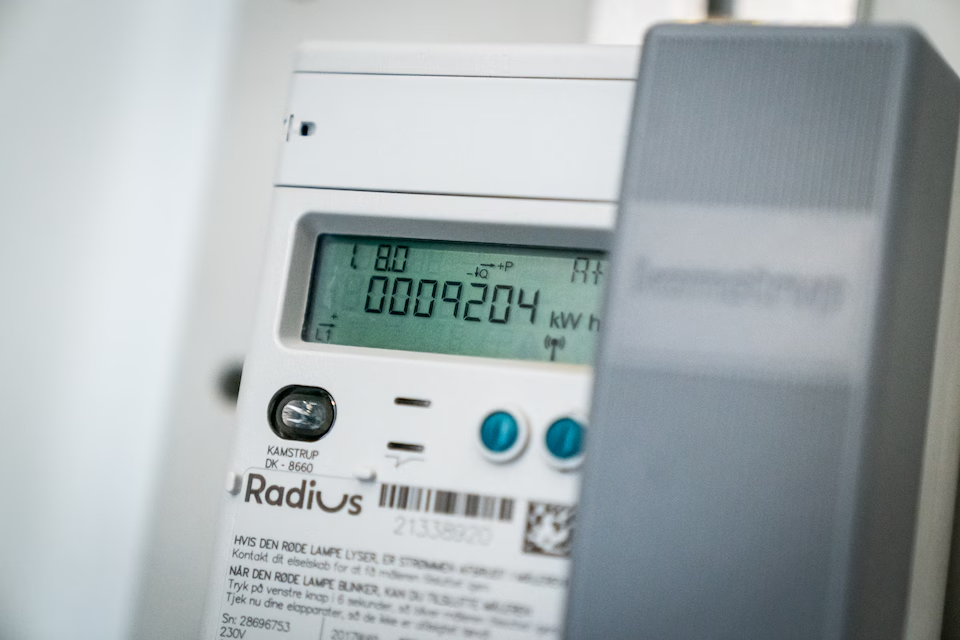Denmark’s government has unveiled an electricity tax cut that would lower the levy to 0.8 øre/kWh—the EU minimum—for 2026–27, aiming to ease household budgets and support electrification.
Timeline and scope of the electricity tax cut (2026–27)
The current electricity tax is 72.7 øre/kWh. Under the plan, the rate would drop to 0.8 øre/kWh from 1 January 2026 and remain at that level through 31 December 2027. Ministers frame the move as temporary relief while prices for essentials remain high.
Household savings on the electricity tax: typical DKK 4,000 a year
Government estimates suggest a typical two‑income family in a detached home could save DKK 4,000 (about €537) per year, while a typical pensioner couple would save DKK 2,700 (about €362). For apartment dwellers with lower consumption, savings scale down accordingly. Additional household electrification—such as heat pumps or EV charging—could further increase annual savings; for example, an EV owner might save around DKK 2,000 (about €268) compared with today.

State budget impact: DKK 7.1bn in 2026 and DKK 7.0bn in 2027
Lowering the tax is projected to cost the state DKK 7.1 billion in 2026 (about €0.95 billion) and DKK 7.0 billion in 2027 (about €0.94 billion). The measure is expected to be included in the forthcoming Finance Bill (finanslov), which must be presented by the end of August. Funding would come from the government’s fiscal room rather than new revenue sources.
Industry reactions and climate impact: electrification gains, limited direct effect
Business groups such as Dansk Industri and Green Power Denmark broadly welcome a lower levy, arguing it strengthens the case for electrification. Climate economists describe the change mainly as a consumer measure with limited direct climate impact unless paired with long‑term certainty that drives investments in heat pumps and electric mobility. Experts also note that a uniform, simple rate removes the need for special low‑tariff schemes for specific technologies.

Political debate: make the electricity tax cut permanent?
Prime Minister Mette Frederiksen (Statsministeren) says the cut is meant to give households “more room in their budgets”. Troels Lund Poulsen (Forsvarsministeren) and Lars Løkke Rasmussen (Udenrigsministeren) have signalled openness to extending the lower rate beyond 2027, while opposition parties on the centre‑right urge a permanent reduction. Others warn that a two‑year window may not be enough to influence long‑lived investments.
EU minimum 0.8 øre/kWh and Denmark’s 2023 precedent
The 0.8 øre/kWh level corresponds to the EU minimum for electricity taxation. Denmark temporarily applied this minimum for six months in 2023 as part of a winter relief package during the post‑Ukraine energy price surge. The new plan would replicate that floor for two full calendar years.

European context: where Denmark’s electricity tax stands now
Denmark remains among the higher‑tax electricity markets in Europe even after recent step‑downs. Cutting the levy to the EU floor is likely to lower bills and support electrification across heating and transport, but its long‑term effect will depend on whether the policy becomes predictable beyond 2027 and how it interacts with parallel measures on food prices, grid tariffs, and renewables build‑out.
If enacted, the electricity tax cut will immediately reduce household costs in 2026–27 and could modestly accelerate electrification. The political debate over making the change permanent will shape both Denmark’s fiscal path and its contribution to the EU’s green transition.






